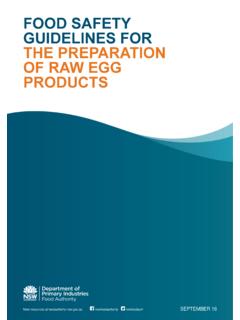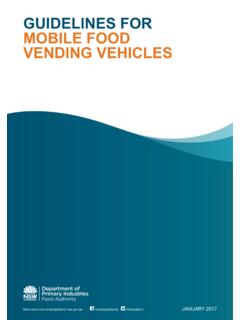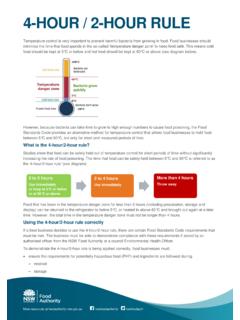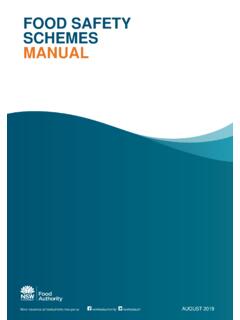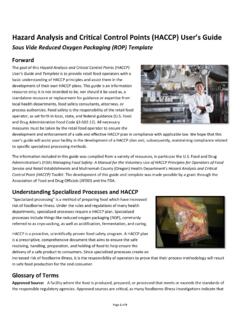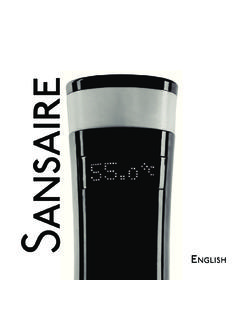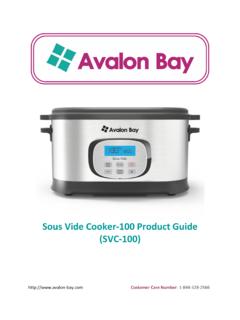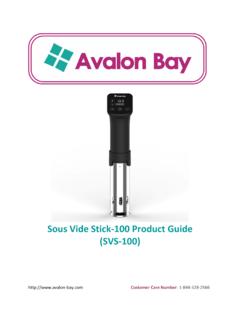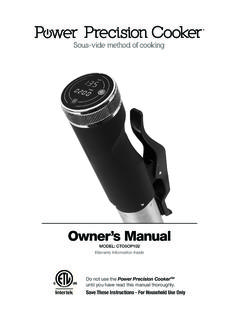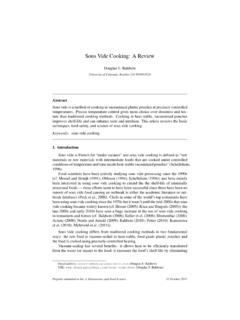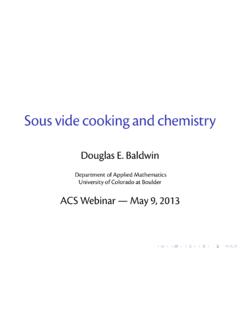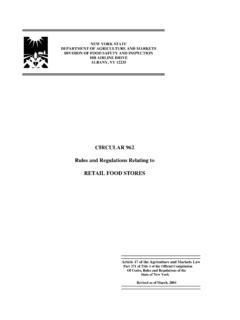Transcription of Sous vide - Food safety precautions for restaurants
1 Sous videFood safety precautions for restaurants NSW/FA/CP058/1207 sous vide food safety precautions for restaurants CP058/1207 Page 1 of 29 Foreword sous vide translates from the French as under vacuum . In culinary terms it has come to mean a process of cooking under vacuum in sealed pouches (oxygen barrier bags), at precise (and sometimes low) temperatures and often for long times. sous vide can be used to prepare foods with an extended shelf life for retail sale or use in food service. However, sous vide can also be used to prepare foods with qualities that cannot be achieved when using traditional cooking techniques. Some sous vide recipes result in food that remains raw or undercooked. This document includes information on the service of raw and undercooked foods. This information is provided in response to a growing trend for sous vide use by restaurants and to encourage the use of safer choices for this type of product: it is not an endorsement of the service of raw or undercooked foods.
2 The onus of delivering a safe product to the consumer resides with the business. The food Standards Code says that a food business must: where a process step is needed to reduce to safe levels any pathogens that may be present in the food , use a process step that is reasonably known to achieve the microbiological safety of the food . Cooking is a process known to achieve the microbiological safety of food and by choosing to serve raw or undercooked animal foods restaurateurs must acknowledge that there will be a residual public health and business risk. Section of this document provides details on the public health risks of raw and undercooked foods. As an alternative to the service of raw or undercooked foods chefs should first consider the service of cooked food prepared using times and temperatures from Table 2 or Table 3 that follow.
3 sous vide food safety precautions for restaurants CP058/1207 Page 2 of 29 Contents Foreword .. 1 Contents .. 2 Executive summary .. 3 Introduction .. 4 sous vide processing .. 5 Concerns about food safety .. 6 food safety hazards .. Low temperature cooking bacterial growth .. Product cooling bacterial growth .. Extended refrigerated storage of food botulism .. Extended refrigerated storage of food li steriosis .. Product reheating bacterial growth .. Serving raw or undercooked foods infectious bacteria, parasites or viruses .. 20 Conclusion .. 24 References .. 25 Appendix: Variation to the 4-hour/2-hour rule .. 28 sous vide food safety precautions for restaurants CP058/1207 Page 3 of 29 Executive summary There are several types of sous vide foods. This document is about food safety hazards of cook serve and short term cook chill sous vide foods.
4 Some issues are common to extended shelf life sous vide foods but guidance on the preparation of these foods is readily available. sous vide seems like a new food service technology but it has a history spanning four decades in France and two decades in other international marketplaces. It finds application in many market segments including extended shelf life ready meals. It is also found in catering companies, restaurants and, increasingly, sous vide has been embraced by home cooks. There is a history of sous vide food causing concern to regulators. There is little evidence of sous vide food causing outbreaks of foodborne illness. However there are foreseeable hazards in three broad areas that must be managed: 1. Foods held in the temperature danger zone, defined as 5 C to 60 C by the Australia New Zealand food Standards Code, for extended periods are potentially subject to bacterial growth, for example, during low temperature long time (LT LT) cooking processes, product cooling or product reheating.
5 2. Foods stored under refrigeration for extended periods are potentially subject to growth by cold tolerant pathogens. The growth of Listeria monocytogenes is a risk as is growth and toxin production by non-proteolytic Clostridium botulinum. 3. food cooked at low temperatures for short periods will, in essence, remain raw and pathogenic bacteria and parasites, if present, might survive. New practitioners of sous vide must be aware of the food safety risks and avoid overly experimental applications of the technology. Today s leaders in sous vide produce quality food without losing sight of food safety . The risks associated with sous vide foods will be reduced if: thinner portions of food are prepared so that heating and cooling are rapid. water bath temperatures of at least 55 C are used so that the growth of Clostridium perfringens is first prevented and then destruction of the cells commences.
6 The time food is held below C during cooking is limited to six hours. commercial equipment with adequate heating capacity and excellent temperature control is used. water and/or food temperatures are checked using a tip sensitive digital thermometer that is accurate to C. prepared foods are not stored for extended times unless processes have been validated. risks are not compounded. Cooking large portions of mechanically tenderised meat for extended times at low temperatures would be irresponsible. if you choose to include on your menu foods that remain essentially raw they should only be served following a request by an informed, healthy adult who willingly accepts the risks associated with raw foods. sous vide food safety precautions for restaurants CP058/1207 Page 4 of 29 Introduction This chart illustrates the variety of processes used to prepare sous vide foods.
7 The blocks with bold font and pink-striped fill relate to extended shelf life products such as ready meals or foods produced by some large caterers. The guidance in this document does not address specific issues relating to extended shelf life sous vide products, for example those with a shelf life greater than ten days. Small portions of food in vacuum pouches90 / 10min Equivalent70 / 2min EquivalentCookHeat without cookingRapid chillRapid chillRapid chill<5 ESL* if validated<5 SSL*<5 only short term storage recommendedRapid reheatRapid reheatRapid reheatCook chill or cook serveCook chill or cook serveCook chill or cook serveCook serve<3 ESL if validatedRapid reheatCook chillPrepareCookChillStoreRe-heatServeTh e Wide Spectrum of sous vide * ESL Extended shelf lifeSSL Short shelf life Figure 1: sous vide processing sous vide food safety precautions for restaurants CP058/1207 Page 5 of 29 sous vide processing sous vide translates from the French as under vacuum.
8 In culinary terms it has come to mean a process of cooking under vacuum in sealed pouches (oxygen barrier bags), at precise (and sometimes low) temperatures and often for long times. Creed (1998) quotes the widely accepted definition developed by the sous vide Advisory Committee (SVAC): sous vide (also known as Cuisine en Papillote sous vide ) is an interrupted1 sous vide can be used to prepare foods with an extended shelf life for retail sale or use in food service. In these examples the interrupted catering system is the relevant characteristic. However, sous vide can also be used to prepare foods with qualities that cannot be achieved when using traditional cooking techniques. In this instance in-pouch cooking under precise and often delicate conditions provides the sought-after characteristics and refrigerated or frozen storage might not be part of the process.
9 Catering system in which raw or par-cooked food is sealed in a vacuumed laminated plastic pouch or container, heat treated by controlled cooking, rapidly cooled, and then reheated for service after a period of chilled storage. The wide range of products known as sous vide can be divided into four broad categories. Processed 90/10. Heated to reduce the numbers of non-proteolytic Clostridium botulinum by This moderately severe process is likely to be used for retail ready meals or extended shelf life cook chill foods. One conventional process calls for the slowest heating part of the food to be exposed to a combination of temperature and time equivalent to 90 C for 10 minutes. Lower temperatures can be used but exposure times increase significantly. Processed 70/2. Heated to reduce the numbers of Listeria monocytogenes by This is commonly known as food pasteurisation and it could be used by restaurants , caterers and some manufacturers of extended shelf life foods.
10 One conventional process calls for the slowest heating part of the food to be exposed to a combination of temperature and time equivalent to 70 C for 2 minutes. Lower temperatures can be used but exposure times increase significantly. Cooked. This term mainly refers to taste, texture and appearance but it has also become associated with certain minimum heating processes for meats. Cooked but not necessarily pasteurised foods will be encountered in restaurants and home sous vide . One process specified by the US food safety Inspection Service (FSIS, 2011) calls for the slowest heating part of the food to be heated to 63 C followed by a 3-minute rest time. Lower temperatures can be used to prepare rare meats but exposure times increase significantly. Higher temperatures are specified for poultry and mechanically tenderised, injected, comminuted or stuffed meats.
